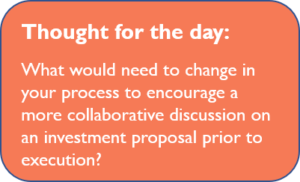 For most people, the word Investment automatically causes us to think about money. As adults, we know that when we invest our money we expect a return and we generally make an investment choice based on our assessment of the value a particular investment will return. We also understand that our funds are limited and that we need to choose carefully because if we make the wrong investment, there is nothing we can do to make it right.
For most people, the word Investment automatically causes us to think about money. As adults, we know that when we invest our money we expect a return and we generally make an investment choice based on our assessment of the value a particular investment will return. We also understand that our funds are limited and that we need to choose carefully because if we make the wrong investment, there is nothing we can do to make it right.
There’s nothing particularly new in the paragraph above – it was true when I managed my first project, and it is true today – but in the intervening years we’ve let IT’s unique circumstances dominate our thinking. In IT, goodness is defined by doing all the projects we possibly can do. In fact, based on hundreds of phone calls – the only time anyone says no is when it is just impossible to do anything more.
Really bad investments are generally (but not always) killed, but marginal investments clog up the system to the point where everything takes longer and costs more. And then to add insult to injury, we start projects where we don’t understand what the outcome should be because “we haven’t finished the requirements.” Then let the project drift along (by filing change orders) until we finally declare some form of success and say it’s up to the business to realize the benefit.
If we considered these investments and not “projects” we’d demand to know what we were buying before we signed the check, the only way to ensure we’d have the kind of information we’d was it to take a completely different approach than we do today. The business case needs to be a collaborative session that includes everyone who is an advocate or will be involved in the realization of the investment. The meeting generally takes between 4 hours for a project and 2 days for a complex project or program.
The outcome of the business case session will be a short but classic business case with a few very significant differences. There will be an investment value specified. This investment value will be a not to exceed price for execution services (the project). It will also include the desired business outcome in a measurable format. For example “we want to decrease raw materials by changing our procurement strategy (by using a reverse auction approach) for acquiring “D” stock. If we are successful, we will see more vendors offering goods (measure 1) and at a 2% lower price (measure 2).
Regardless of how we chose to develop the software needed to realize this business capability we know what the scope is (reverse auction system) and what the outcome is (more vendors leading to lower-priced D stock). Anything that doesn’t ensure measure 1 or measure 2 simply doesn’t need to be done as part of the approved investment.
I’ve chosen to highlight just one element of the Business Agile Investment Portfolio practice in this blog because I believe that this one change alone will save time, money and deliver higher quality outcomes. There’s been a belief in the agile community that to be agile; you need to adopt a completely different approach than anyone has used in the past. I disagree — you can’t get a quality investment portfolio just using Kanban (as good as Kanban maybe for other things). You can get it using time-tested techniques applied with an agile mindset.


